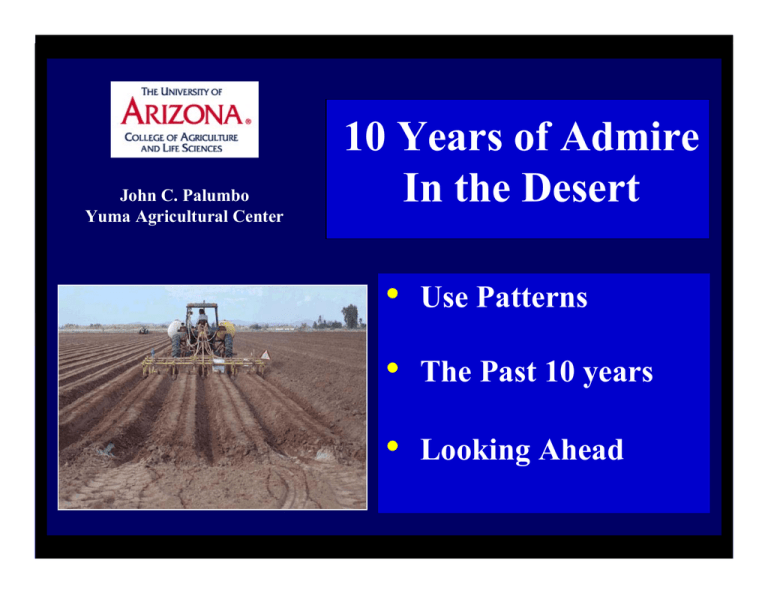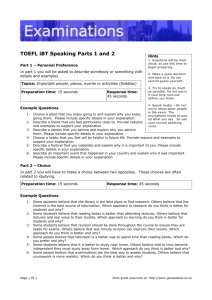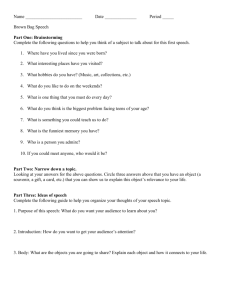10 Years of Admire In the Desert • Use Patterns
advertisement

John C. Palumbo Yuma Agricultural Center 10 Years of Admire In the Desert • Use Patterns • The Past 10 years • Looking Ahead Admire® (imidacloprid) • Soil-applied, systemic compound that effectively controls sucking insects • Novel mode of action –acts as a agonist by binding to post- synaptic Nicotinic receptors • Flexible use patterns • Selective activity Admire Most effective when: * Applied at planting with label rates (12-20 oz) * Placed below the seed during shaping/ planting * Injected through drip after stand establishment Soil Applications • Chemical does not readily move in soil • Placement is important V Key to performance: * Place Admire where it will stay in an aqueous solution within the root zone of the plant. Chemigation via drip irrigation may be the most optimal application method Seasonal WF * Leafy Vegetables Dynamics 85 Average Temp (oF) 75 65 Relative Pest Abundance 55 Whitefly At planting Planting Sep Oct Harvest Nov Dec Jan Feb Mar Apr Admire How does it work ? Immatures Eggs– Little to notoxicity effect Adults - Direct - Repellency Crawlers --feed upon hatching Anti-feedant and are highly susceptible 1 Eggs Admire Efficacy Adult Crawler 1st Instar 2nd Instar 4th Instar REN 3rd Instar Whiteflies and Aphids in desert vegetable producing areas have not affected Yield or Quality since Admire has been used on an areawide basis for the past 10 years. 10 Years of Admire in The Desert Whitefly outbreaks from 1991-1993 caused $$ millions worth of damage to vegetables and melons in AZ/CA. Production of winter Admire vegetables and melons Sec 18 : 1993-1995 in 3: the desert Sec 1995 was in jeopardy Whiteflies in the 90’s • Reduced Yields - leaf necrosis - fruit size - plant vigor • Reduced Quality - Low sugars - sooty mold Admire Untreated Untreated Untreated Admire Admire Performance of Admire in Commercial Lettuce Yuma, Gila, & Dome Valleys 2 Whitefly nymphs / cm n = 5-8 fields Field Standard (Admire - 16 oz) Untreated Field Plots 50 40 30 20 10 0 93 94 95 96 97 98 99 00 01 Admire vs. Untreated (1993-2002) Application methods Admire Rates Insect Evaluations } Same Each Year 10 Years of Admire in the Desert Fall and Spring Melons Mean SWF Nymphs / cm2 / leaf 500 Silverleaf Whitefly Adult Activity (Seasonal Avg) Eggs Untreated Admire 16 oz 400 300 200 100 0 S F 1993 S F 1994 S F 1995 S F 1996 S F 1997 S F 1998 S F 1999 S F 2000 S F 2001 S 2002 10 Years of Admire in the Desert Fall and Spring Melons Mean SWF Nymphs / cm2 / leaf Silverleaf Whitefly Nymph Control (Seasonal Avg) Nymphs 160 Untreated Admire 16 oz 120 80 40 0 S F 1993 S F 1994 S F 1995 S 1996 F S 1997 F S 1998 F S 1999 F S 2000 F S 2001 F 2002 S Whitefly Egg Densties on Fall Melons (% reduction compared to untreated check) Mean SWF Eggs / cm2 / leaf 500 Untreated Admire 16 oz 400 300 200 (70) 100 (74) (93) (72) (89) 0 94 95 96 97 98 (83) (77) 99 00 (83) 01 Whitefly Nymph Densties on Fall Melons (% reduction compared to untreated check) 200 Untreated Admire 16 oz Mean SWF Nymphs / cm2 / leaf 180 160 140 120 100 80 60 40 (82) (76) 20 0 94 (90) (85) (97) (95) 95 96 97 98 99 (82) (90) 00 01 Fall Melons 2001 Pre-harvest (60 DAP) Admire Untreated check Seasonal Whitefly Densities - Spring Melons 60 Eggs Untreated Admire 16 oz 40 2 Mean eggs / cm / leaf 50 30 (38) 20 (33) (43) (61) (78) (81) (72) 10 (57) (96) 0 93 Admire 24 oz 94 95 96 97 98 99 00 01 02 Seasonal Whitefly Densities - Spring Melons 40 Nymphs 2 Mean nymphs / cm / leaf 35 Untreated Admire 16 oz 30 25 20 15 10 (57) (95) (53) (75) (29) (75) (50) (66) (84) (84) 5 0 93 Admire 24 oz 94 95 96 97 98 99 00 01 02 Mosaic Viruses ZYMV, WMV2, PRSV * very low incidence in AZ / CA melons since 1993 Cucurbit Leaf Curl Virus * Geminivirus first reported in 1998 * no economic damage reported in commercial fields Admire • Conservation of natural enemies • Easy on pollinators ® The removal of Phosdrin from the market in 1993-1994 caused serious concern for the future of aphid control in lettuce Season-long Control of Green Peach Aphid In Head Lettuce at Low Rates Yuma Ag Center, 1994 100 Mean Aphids Per Plant Untreated 80 60 Standard Foliar Admire 20 oz Admire 16 oz Admire 12 oz 40 20 0 60 70 80 90 Days After Planting 100 110 Head Lettuce Systemic translocation of Admire in frame leaves in first 60 days prevents GPA from significantly colonizing lettuce plants 10 Years of Admire in the Desert 500 Green Peach / Potato Aphid Complex - Harvest Densities Untreated Admire 12-16 oz Mean Aphids / Plant 400 300 200 100 (91) (95) (96) (96) (94) 93 94 95 (97) (98) (97) (98) 96 97 98 99 (99) 0 00 01 02 Rainfall (inches) 6 Annual Seasonal Rainfall (Sep-Apr) 5 4 3 2 1 0 Untreated Admire 12-16 oz Mean Aphids / Plant 400 300 200 100 0 93 94 95 96 97 98 99 00 01 02 Sustained Admire Efficacy In Desert Crops - 10 Years • Large, untreated host crop acreages • Diverse seasonal crops with alternating insecticide use patterns • Population Dynamics • Inherent Toxicity of soil-applied Imidacloprid So what’s to be concerned about ? Neonicotinoid Chemistry N N NH Cl Cl N O2N N N NC Thiacloprid S N CALYPSO Imidacloprid N ADMIRE PROVADO Cl O Cl S N Thiamethoxam NC N ASSAIL H N N O 2N PLATINUM ACTARA Acetamiprid N N N O NH N O2N Dinotefuran So what’s to be concerned about ? 1) Expanded registrations of neonicotinoids: • Actara/Platinum/Centric: cotton, melons • Assail/Intruder: cotton, leafy vegetables • Calypso: (labels pending) • Dinotefuron (labels submitted to EPA) 2) Multiple applications allowed by labels. 3) Lack of Alternative Chemistries in the Pipeline 4) A Real Risk of Resistance Sustaining Neonicotinoid Efficacy in Multi-crop Communities Winter Vegetables Spring Melons Cotton Fall Melons Draft Proposal Cross-commodity Guidelines for Neonicotinoids 1) Multi-crop Communities Cotton: Do not apply neonicotinoids in cotton. Centric, Leverage, Intruder. Melons /Vegetables : •A single neonicotinoid use (soil or foliar) per crop • Do not apply a foliar neonicotinoid spray after the use of a soil application of Admire or Platinum. Draft Proposal Cross-commodity Guidelines for Neonicotinoids 1) Multi-crop Communities (YUMA) Melons /Vegetables : • Consider foliar alternatives for vegetables that are planted after WF movement subsides and harvested before aphids typically become abundant. (e.g., October in Yuma Valley) Resistance Risks Associated with Shared Neonicotinoid Uses in a Multi-Crop Community (eg., Yuma – current usage) Relative Whitefly Population Abundance Melons Neonicotinoid Resistance Risks Associated with Shared Neonicotinoid Uses in a Multi-Crop Community (eg., Yuma – current usage) Melons Relative Whitefly Population Abundance Vegetables Neonicotinoid Resistance Risks Associated with Shared Neonicotinoid Uses in a Multi-Crop Community (eg., Yuma – potential usage) Melons Neonicotinoid Vegetables Relative Whitefly Population Abundance Cotton Not Sustainable Preserve a Neonicotinoid-free Period in Multi-Crop Communities (e.g., Yuma-Recommended) Melons Neonicotinoid Vegetables Relative Whitefly Population Abundance Cotton IGRs and Conventional Draft Proposal Cross-commodity Guidelines for Neonicotinoids 2) Cotton–intensive community • No more than 2 neonicotinoid uses per cotton crop • Sprays should only be used following an initial IGR spray (Stage II of IRM Program) • Sprays should not to be applied consecutively, but rotated with conventional chemistries (Stage II or III) Resistance Risks Associated with Neonicotinoid Uses in a Cotton-intensive Community (e.g., Buckeye-label max) Neonicotinoid Relative Whitefly Population Abundance Cotton F5 Leafy Vegetables F3 F6 F7 F8 F4 F2 F9 F1 J F M F10 F12 F11 A M J Ju A S O N D “ Remember the Pyrethroids ” Resistance Risks Associated with Neonicotinoid Uses in a Cotton-intensive Community (e.g., Buckeye-recommended use ) AZ Whitefly IPM Program I II III Cotton Relative Whitefly Population Abundance IGRs Neo Pyr F5 Leafy Vegetables F3 F6 F7 F8 F4 F2 F9 F1 J F M F10 F12 F11 A M J Ju A S O N D Whiteflies and Aphids in desert vegetable producing areas have not affected Yield or Quality since Admire has been used on an areawide basis for the past 10 years.





